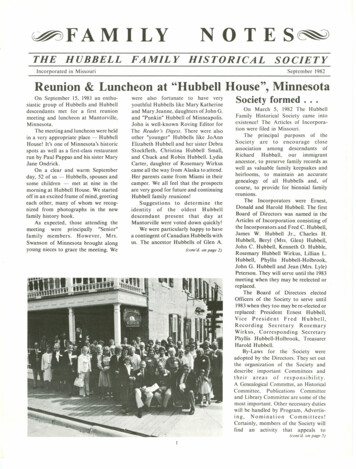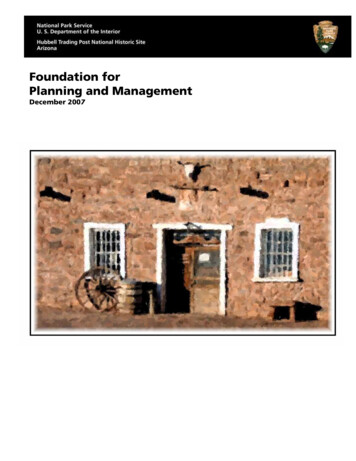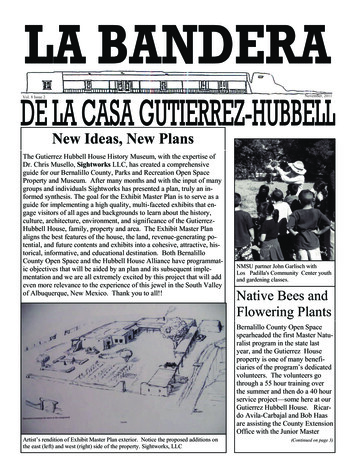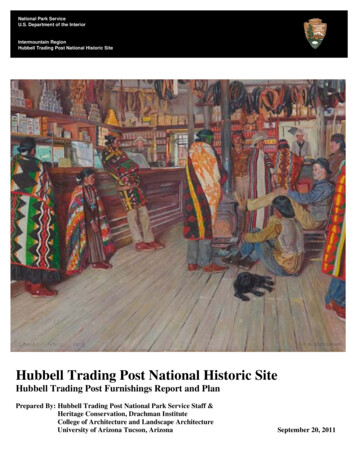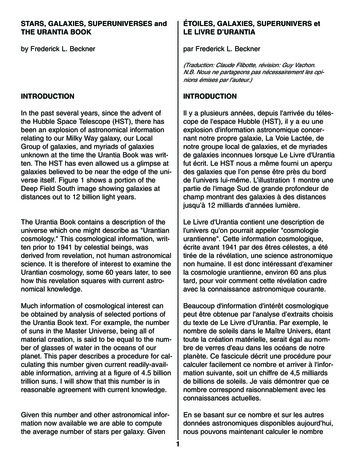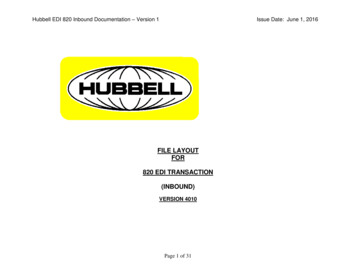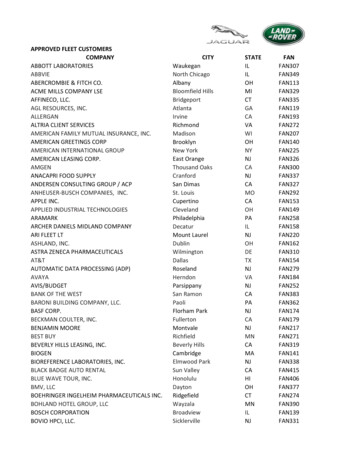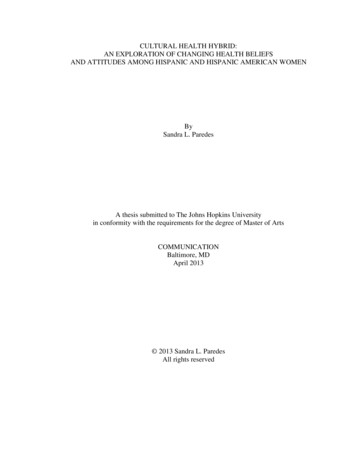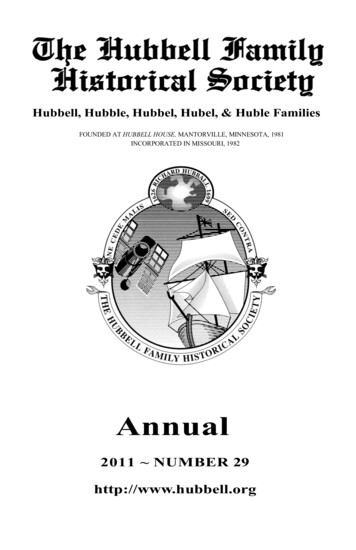
Transcription
Hubbell, Hubble, Hubbel, Hubel, & Huble FamiliesFOUNDED AT HUBBELL HOUSE, MANTORVILLE, MINNESOTA, 1981INCORPORATED IN MISSOURI, 1982Annual2011 NUMBER 29http://www.hubbell.org
Annual2011 NUMBER 29Distributed to members of The Hubbell Family Historical Society.Editor: Richard W. Hubble, 626 Birch Ave. San Mateo, Ca. 94402E-mail: hubblerw@comcast.netEditors Emeriti: Harold B. Hubbell 1983-1990; Jean Hubbell Peterson 1989 & 1990(Family Notes); Robert L. Hubbell 1991-1997; John A. Hubbell 1998-2009THFHS Annual Dues:Payable by check in U.S. or Canadian dollars(See the Membership Form included with this Annual)Regular Member (individual / husband & wife) . 15Contributing Member . 50Participating Member . 100Proud to Be a Hubbell/Hubble . 200Societies and Libraries . 10Membership/Reunion Meetings are held every two years. The next Biennialwill be held in June 2013 in Des Moines, Iowa.For further information write the Society at: Laura M. Hubbell, Membership Chair1404 So. 304th StreetOr visit our website at:Federal Way, Wa. 98003www.hubbell.orgE-mail: membership@hubbell.orgPUBLICATIONS OF THE SOCIETYAdditions and Revisions to the History & Genealogy of the Hubbell Family, 1995, by Harold B.Hubbell and R. Leroy Hubble, 1158 pages, 251 photographs, indexes: US 65.00, C 90.00 tomembers; US 80.00, C 95.00 to non-members.History & Genealogy of the Hubbell Family, 1980, by Harold B. and D. S. Hubbell, reprinted1998, 1089 pages with index: US 70.00, C 98.00. Separate index, 205 pages: US 25.00,C 35.00.Family Fare, 1989, compiled and edited by Catherine H. Welsman and Betty W. Hubbell; the Society’scookbook, 255 pages with recipes and anecdotes, index: US 15.00, C 20.00.Hubbell Pioneers, 1989, begun by D. S. Hubbell, completed by family members under CliftonH. Hubbell; illustrated biographies of family first-comers in each state and in Canadian Provinces,432 pages, index: US 40.00, C 54.00.A Military History of the Hubbell Family in North America, 2001, by Hilbert R. Hubble; eachchapter discusses a major period in North American military history from the Colonial period untilKosovo, providing a description of all Hubbell service men and women for which a record can befound. 618 pages, 200 illustrations, 18 chapters and 29 appendices. All fully indexed. US 57.50,C 91.50.Hubbell By Choice: The Ancestry of Some Early Connecticut Women, 2008, by Mary AnnHubbell & Marjorie Hubbell Gibson. This book unlocks the history of lives of some women in theseventeenth century and looks at the ancestry of those who married into the first three generations ofthe Hubbell family. 399 pages, 8.25" x 10.75", casewrap-hardcover binding. ISBN: 978-0-96230974-8. US 48.00. Available now for purchase at: lulu.com: http://www.lulu.com/content/1897644
Hubbell, Hubble, Hubbel, Hubel, & Huble FamiliesCONTENTS OF ANNUAL 2011The SocietyOfficers and Directors . . . .2A Message from Your President . 3Rock Church-A letter of Appreciation 5Note From Your Editor .6THFHS Committees List .29Committee ReportsScholarship Fund . .30Hubbell Center Board of Directors Meeting. .30Treasurer’s Report .31Reunion Meeting Notes1st Board of Directors Meeting .342nd Board of Directors Meeting . 351st Members Meeting . .362nd Members Meeting . .37Biography & HistoryLaporte Hubbell: A 19th Century American Clockmaker.7GenealogyGenealogy Updates . .39Membership Roster . . .41Obits:Dr. John P. Hubbell .45Sally Jo Hubbell Carey 45Robert “Camino Bob” Hubbell 46Necrology . . .Back PageFOR CORRECTIONSThe Membership Committee devotes a special effort to getting all names correct, according to Members’ instructions, and to listing all code numbers when known. The Editor hopesMembers will inform us of any missing or incorrect number, or any other inaccuracies in thelist. Please inform the Society of changes in mailing address when moving.1
The Hubbell Family Historical SocietyOFFICERSPresident .Peter O. Hansen (#6506)Vice-President .Marjorie H. K. Hlava (#8667)Secretary . Dorcas Aunger (#8877)Treasurer .Janyce Hubble Fulton #12672Genealogist Hilbert R. Hubble #9750Editor .Richard W. Hubble #12731DIRECTORSEligible until 2013:Joanne M. Canen (#8590)Janyce Hubble Fulton #12672Dorrance S. Hubbell #11180Donald C. Hubbell #8625Janet Watson (#4266)Gerald R. Hubbell #11207Myrna Kepford #12146Robert McOrmond (#8630a)Jean Norford Hubbell #8668Eligible until 2017:Dorcas Aunger (#8877)James D. Hubbell #11206Hilbert R. Hubble #9750Roger Hubbell #13278Wilson G. Hubbell II #14416Susan Okoniewski #9752Eligible until 2015:Barbara Kruse (#5327)Peter O. Hansen (#6506)Betty Jo Chapman (#3933)Hubbell Center Library Museum ArchiveOFFICERS AND DIRECTORSPresident . .James W. Hubbell, III #13423Vice President Harvey Hubbell, V #11025Secretary . Peter O. Hansen (#6506)Treasurer. Mike Hubbell #13426Genealogy .Hilbert Hubble #9750Librarian/Curator Patricia Dawson **Jack Jerome Hubbell #10601Hilbert R. Hubble #9750William B. Friedricks**G. Thomas Sullivan**Administrator of Hubbell Website: Chris Boggs E-mail: chris@chrisboggs.com**Not a Hubbell descendant (3 required by IRS ruling)2
A MESSAGE FROM YOURPRESIDENTDear Cousins,2011 was a SUPER year for ourFamily Society. Our Salt Lake Cityreunion last June hosted by Jim and MaryAnn Hubbell and family was a blast. Notonly was it genealogically educational, butrecreational events were too. The auto/bustours were much fun. Meals were uniquewith lots of food. It was nice seeing manyof you who attended, and thanks to thosewho brought memorabilia to show andstories to share.Next, I have something exciting to tellyou about. A unique new introduction intoour genealogy library at Hubbell Center is“The Hubbell Family DVD”, which contains thousands of images of the originalsource material which were used to prepare the two book volumes of Hubbellfamily history: History and Genealogy and Additions and Revisions. The DVDhas an index, and images are in PDF format and keyword searchable. Moreabout this and how to purchase it coming up in our 2012 Spring Family Notes.THFHS website, www.hubbell.org, has become first class with the work ofCarol Boggs and son Chris. Look under the News tab; Members. Now see theirbutton to obtain all sorts of info; Officers including Board Members andCommittee Chairpersons have a different button to obtain detailed info regardingeach other’s phone numbers and addresses. Both require a password. E-mailofficers or myself for this when needing it. Carol Boggs is looking for areplacement for the administrator position for the website; let either of us knowif you are interested and can help.Laura Hubbell, our new Membership Chairperson from Federal Way, WA.has picked up steam with welcoming a dozen or so new members since lastJune and this brings our current membership to around 420.Financially, Treasurer Jan Fulton tells me we are in good shape. Jan hascome up with several new options for moving Society merchandise at a discountto members. Take a look at the new merchandise list and save some .The Hubbell Family Foundation Fund in Des Moines is doing well despitethe economy.Hubbell Center, which has a Board of Directors and not a membership likeTHFHS, had its annual meeting in Des Moines, IA. on December 6th. HarveyHubbell V and I flew in spending two nights and the day. It was rather excitingseeing the collectable Hubbell items coming into the museum which PatriciaDawson, our librarian, is categorizing. The Board welcomes Michael HubbellCon’t on next page3
of Des Moines who recently joined the Board as its Treasurer, and HannahHerzog as Social Media Director who has set HC & THFHS up on Facebook. Iencourage you to look at the minutes which you will find elsewhere in thisannual.The Des Moines Hubbells are looking forward to our next reunion there inJune 2013. THFHS Board of Directors will be having its 2012 interim meetingthere the last week of April to further firm up the foundation for our 2013Biennial Reunion. There are more exciting things for families to do in DesMoines than one can imagine .farm visits, river tubing, Saturday market, FunRun, covered bridges, Iowa Cubs Baseball game (if in town) .and theGovernor’s Mansion to visit (F. M. Hubbell’s home). Put it on your calendarfor June 2013. Can you think about it?This wraps it up. Our efficient and organized Family Editor, Rick Hubble,has drawn the line and I have to email this to him tonight. I am enjoying,heading up as your President, the wonderful team of Hubbell Volunteers and allthey do for our Society.Peter O. Hansen, M. D. Practicing Family Physician pohansen@alaska.netHubbell Center Officers:From left to right: Pete Hansen, Hanna Herzog, Jim Hubbell III, Pat Dawson, Harvey Hubbell V,William Friedricks and Thomas Sullivan. Not pictured are Hilbert Hubble and Jack J. HubbellItem recently on e-bay: 1800’s Classic Boot Knife stamped ‘HUBBELL Q. E. D. RANDALL’10 inches over all length . 5-7/8 inch dagger-like blade4
Letter of Appreciation from Rock ChurchThe Hill House RockNr. Kidderminster DY14 9STTel. 01299 266353October 4th 2011Mr. Peter 0. HansenPresident of the Hubbell Family SocietyPO Box 1390Kenai, AK 99611-1390Dear Mr. Hansen,I was very pleased to receive your letter this morning and particularly the enclosedcheque for 250.00 from the Hubbell Family Historical Society. May I, on behalf of theFriends of Rock Church thank you all sincerely for your generous donation to our funds.As mentioned in my letter of June 16th 2011 our organization has been raising funds to carryout a repair/improvement project to the approach to the main entrance of our Church.We are planning to progress the project this autumn, although we still have, as of today, ananticipated shortfall. I can assure you that your generosity has indeed come at a veryappropriate time and is much appreciated.I will be pleased to send you a progress report and possibly photographs of the completedwork in due course.Once again, very many thanks for your interest and generosity.Yours sincerely,W. John W. NottChurch WardenUnusual Post Card for sale on e-bay5
From Your EditorThe Annual and Family Notes has experienced many changes in its 28 yearsunder the guidance of 4 previous editors. Like my predecessors, I am wellaware that the quality of our publications is a reflection of the capability anddedication of you, the members. What has remained constant is the editor’sdependence on the generous contributions of our members to share theirexpertise and enthusiasm. My success as editor is dependent on you, the readers,submitting material for publication.We are always in need of current event stories for our Family Notespublications and historical and biographical stories for the Annual. There ismuch to document in our extended families and I hope you will share thesestories with all of your cousins. Sadly, when writing the article on LaporteHubbell in this year’s Annual I had to rely on second hand information to tryand understand the man and his times. How nice it would have been if more ofthe story of Laporte had been personal and family remembrances.Your Editor,Richard W. HubbleLaporte Hubbell Family Grave in Forestville, CT6
Biography and HistoryLaporte Hubbell: A 19th Century American ClockmakerBy Richard W. HubbleAt the beginning of the 19thCentury, the countryside aroundBristol, Connecticut was poised tonurture the birth of the Americanclockmaking industry. Starting withwooden movements made fromlocal timber, and later transitioningto brass, Bristol’s dominance wouldlast well into the 20th century. Oneof these Yankee clockmakers,though not well known outside thebusiness, had a significant influenceon the industry. That clockmakerwas Laporte Hubbell, an ingeniousmechanic who developed andproduced clock movements for theindustry for 40 years. Few clockscarry his name but many contain hismovements.Laporte Hubbell: 1824-1889Born in 1824, Laporte Hubbell (A&R# 1904) was one of twelve childrenborn to William R. Hubbell (A&R# 814) and Juliann Botsford. William R. wasborn in Newtown, CT in 1792 and moved to Bristol about 1816. He marriedJuliann, a year later, in 1817.(1) An 1852 map, located in the Bristol PublicLibrary, documents the location of the house where Laporte was born. Thehouse, built in 1812, remained in the Hubbell family until the 1960’s and stillstands today (2011) at the corner of South Street and Mt. Road. (See Pictures 1& 2)Little is known about William R. Hubbell’s life. Two letters, written toWilliam, were uncovered in the American Clock and Watch Museum in Bristol,CT. The letters indicate that at least from 1828 to 1831, William was in theframe or window making business. The first letter, dated Oct 4, 1828 andpostmarked Oct 5 New York, is a request for William to make some frames.The first part of the letter reads:“Dear SirThere are several of the merchants here have proposed to me tocommence making slate(?) frames which they say we can do toCon’t on next page7
advantage-one of them has about 100 doz. Plates on hand which hewants to frame immediately. I have accordingly thought ofconsulting you on the subject and if you think best to make someexperiments for that purpose .”The letter continues detailing the size of the frames of approx nine by thirteeninches. The reference to “slate” frames is interesting as there are no slatedeposits around Bristol. The letter suggests that William was in the businessbefore 1828.The second letter dated Nov 12, 1831 is from a Mr. Rails (?) of Philadelphia,PA and is also a request for many 8x8 inch frames. These 2 letters suggest thatWilliam R. had a thriving frame or window making business with customersfrom as far away as Pennsylvania. The 1995 A&R contains a note under EllenHubbell (A&R# 3752) that states she donated her father’s business letters to theConnecticut Historical Society.(1) A portion of the entry states:“she was a member of the Colonial Dames, and donated businesspapers to The Connecticut Historical Society’s ManuscriptCollection: letters directed to her father from a Philadelphia salesagent 1828-1840 and receipts for boxes of glass received on boardvarious steam vessels at Hartford destined for Philadelphia dated1828-1856”.For clarification, Ellen Hubbell’s grandfather was William R. Hubbell and herfather was William (A&R# 1907). These donated letters, documenting awindow frame business from 1828 to at least 1856, belonged to William R.Hubbell, Ellen’s grandfather.(2)Picture 1: Location of the William R. Hubbell home in Bristol, CT. and the birthplace of Laporte.The Birge, Peck & Co. factory is located in the upper left hand corner. This is where Laporte startedworking at the age of 12. The distance from the house to the factory is less than a 1000 feet. Froman 1852 map of Bristol and Forestville, CT. located in the Bristol Public Library8
Picture 2: William R. Hubbell house; Bristol, CT in 2011Two additionalpieces of informationabout William R.’s lifeinclude an entry in theJerome, Grant & Co.(clockmakers) ledgerthat shows that aWilliam F. Hubbell waspaid 5.00 for tenbushels of corn inDecember 1842.(3) Asthere were no otherWilliam Hubbell’sliving in Bristol at thistime (except for his sonWilliam who was 5years of age in 1842) this must be William R. and suggests that he may havebeen employed, at least part time, by the Jerome, Grant & Co. clockmakingbusiness sometime between 1842 and 1846. Also employed by Jerome, Grant &Co. during this same time period was William R’s oldest son (Laporte’s brother),Fayette M. Hubbell (A&R# 1903).In 1831, William R. is recorded as having a pew in the newly builtCongregational Church in Bristol.(4) Among other noted members of thischurch were the clockmakers Joseph Ives, Elisha Manross, Elias Brewster,Chauncey Boardman and John Birge, five well known early Bristol clockmakers.John Birge, and to some extent Elisha Manross, would play a role in Laporte’scareer.Period 1: 1836-1848John Warner Barber in his “Connecticut Historical Collections”describes Bristol, CT, in 1836, as “a manufacturing town, and the inhabitants aredistinguished for their enterprise and industry-there are at present 16 clockfactories, in which nearly 100,000 brass and wooden clocks have beenmanufactured in a single year”.(5) In 1836, at the age of twelve, and with only agrammar school education, Laporte Hubbell went to work as an apprentice ofThomas F. Fuller in the clockmaking concern of (John) Birge and Fuller.1836-1837 also corresponds to the start of two major upheavals in theclockmaking industry. First, a country wide financial panic, beginning in 1837,held the country in a depression for a couple of years and forced a number ofwell known Connecticut clockmaking firms into bankrupt. Secondly, a majortransition from mass produced wooden clock movements to massed producedrolled brass clock movements was taking place. This transition occurred around1836-1839 and was important because Laporte probably began his training, orCon’t on next page9
Figure 1: Laporte Hubbell Family Genealogyquickly transitioned to the new mass produced brass movements during the earlypart of his training.Laporte continued to work in the clock industry, for a number of differentcompanies including Birge, Mallory & Co., Birge, Peck & Co. and Smith &Goodrich from 1836 until 1848.(6)10
In 1846, Laporte, at the age of 22, married his 1st cousin, Lucy M. Hubbell(A&R# 1898). (See Figure 1)Period 2: 1848-1851: The BeginningIn June of 1848, the clockmaking firm of Hendrick, Barnes andCompany was formed. The principals in this company were Ebenezer Hendrick,William B. Barnes, Rodney Barnes, Daniel Clark and Laporte Hubbell. Thisfirm was formed to manufacture a new type of brass clock that is referred to asthe marine clock or balance wheel clock.What we know of the founding and early years of the firm come fromtwo primary sources. The story of the founding of the firm comes from a fourpage letter, written by Rodney Barnes around 1876, that was found in EdwardIngraham’s library.(7) This letter was published in “The Timepiece Journal ofthe American Clock and Watch Museum” (8), and in the local Bristol newspaper(The Bristol Press).(9) The second source of information on the early years ofthe Company come from Rodney Barnes’s account books.(10)According to Rodney Barnes, he approached Ebenezer Hendrick in1848 with the idea of forming a company for the purpose of manufacturing aclock that his brother, William Bainbridge Barnes, had designed. EbenezerHendrick was a financier in the Bristol area and was involved in the financing ofa number of clock companies. The new company leased the old Elisha Manrossclock shop on the west side of Frederick Street. This shop originally had beenJoseph Ives’ shop and is reportedly the first manufacturing business inForestville, CT. Ives built the shop in 1811.(4) In 1848, Forestville was a smallhamlet about one or two miles from downtown Bristol. Today, Forestville hasbeen incorporated into the town of Bristol.In 1849, Laporte’s first sonMarshall Upson Hubbell(A&R# 3741) was born.Picture 3: An example of a “typical” Laporte Hubbell 30 hourmarine or balance wheel movement11In July of 1850, E.Hendrick and L. Hubbellpurchased the clock shopfor 2000. By the end of1850, the Companyemployed nineteenworkers and produced15,000 brass movementsper year.(6) The quicksuccess of the Companywas reportedly due to theenergy and abilities ofLaporte Hubbell. QuotingRodney Barnes:Con’t on next page
“they were successful, and in justice to Mr. Hubbell I will say thatthe success of the firm was owing, to a great extent, to his zeal. Heworked early and late, hardly taking time to eat and sleep. Hemade the dies and punches with his own hands. He also madewhat is called a punch box, used in punching holes in the plates forpivots. It was a very delicate job, and, besides he had very fewtools to work with. Mr. Hubbell has been through a great manyhard struggles, and I am happy to say has been crowned withsuccess”.(9)High praise, indeed, from a co-owner and peer. The letter also states thatChauncey Jerome bought all the clocks made by this firm in these early years.This was not an unusual collaboration in the clock industry. Many well knownclockmakers would buy clock movements and /or cases from other shops,assemble them, and then sell the finished clock under their name.The marine movements that the new Company produced were in highdemand as boat and rail traffic increased in America. Marine chronometers,developed in the middle of the 18th century by the Englishman John Harrison,were similar in design to the marine movement being built by the newCompany.(11) These exceptional timepieces, although very accurate, were veryexpensive and difficult to make and thus not an option for most Americans.Reliable and moderately priced pocket watches would not be available foranother 20 years and pendulum clocks could not keep time on a moving train orboat. Thus there was considerable effort to develop the marine or balance wheelclock in the middle of the 19th century. Refer to the discussion with Pictures 4& 5 for further information on marine clocks.In the early 1840’s, American clockmakers started experimenting withbalance wheel or marine movements that were cheaper and easier tomanufacture than the marine chronometer. They experimented with newdesigns and tried modifications to the marine chronometer designs beingdeveloped in England and France. For a review on the development of differentexcapements, which became precursors to the clock marine movements, seereferences 12 & 13.Silas B. Terry experimented with pendulum-balance wheel hybrids andlater used his father’s balance wheel patent (patent # 4139 assigned in 1845) toproduce a number of marine clocks.(14, 15) None of them were commerciallysuccessful. Charles Kirk, another Bristol clockmaker, patented (in 1848) andproduced a marine movement using two excape wheels from 1847 to 1853. Hisdesign was put into production and had limited commercial success.(16, 17)Other competitors, in the early 1850’s, for the marine clock businessincluded Samuel Botsford working simultaneously with Jewell, Mathews & Co.from 1851 to 1853 and the Litchfield Manufacturing Co. from 1850 to 1854 andlater with the Marine Clock Mfg. Co. from 1857 to 1863.(18) He designed a12
Balance Wheel andPendulum ExcapementsIn both marine and pendulum clocksthe wheels (2,3,4 and excape wheel inthis example) are held under tension bythe spring attached to wheel 1. All thewheels would spin if not held in checkby one of the two ends (pallets) of theverge. When the marine clock is“running”, the balance wheel and springrotate back and forth moving the leverand verge up and down. Thismovement both releases the excapewheel from one pallet and tooth whilethe other pallet catches another tooth onPicture 4: Laporte Hubbell’s marine or balance wheel the excape wheel and stops it frommovementfurther rotation. This action isindependent of the orientation of theclock. This is called the marine orbalance wheel excapement and is thebasic design for the modern alarmclock.The excape wheel, in a pendulum clock,is released and captured by the sameback and forth movement of the verge.However, the release and capture of theexcape wheel is sustained by thependulum’s back and forth movementand this movement is dependent on theforce of gravity. An upright and verticalposition for this clock is essential. ThisPicture 5 Typical 19th century pendulum movementunique movement called the Botsford Movement. Noah Pomeroy developed aunique movement that was in limited production from 1849 to 1878.(4)Although the above competitors developed unique movements that bear littleresemblance to William Barnes’ movement, none of these competingmovements were of a robust design, consequently, they were not economical tomanufacture and maintain and thus are relatively rare today. (10, 19) Otherearly balance wheel movements have been identified but they appear to becopies of the Barnes movement.Con’t on next page13
Period 3: 1851-1855: The NewCompany Continues To GrowIn 1851, the Barnes brotherssold their shares in the Company andthe name of the firm changed toHendrick, Hubbell and Company.Rodney Barnes continued as acontract machinist, supplying clockparts to Hendrick and Hubbell andto other clock companies for the nextPicture 6: Laporte Hubbell’s new house built30 years. He also supplemented hisaround 1851 in Forestville, CT.income with other odd jobs and washeavily involved in real estate development in Forestville. (4, 9) WilliamBarnes retired from active work in 1845 after being kicked in the head by ahorse and having a 2x2 inch piece of bone removed from his skull. (20)Despite the accident, he designed the 1848 marine movement and in 1860, heapplied for and was granted a patent (# 30,558) for the redesign of a pendulummovement. Daniel Clark’s involvement with the Company, at this time, isunknown.Business was very good for Laporte and his family continued to grow.In 1851, Laporte’s second son, Walter C. (A&R# 3742) was born. In 1851,Laporte built a new home in Forestville. The same 1852 Bristol area mapreferenced above, features a vignette of Laporte’s new house. (See Picture 6) In1853, both daughter Lillah M. and his 3rd son Frederick Laporte (A&R#3743) were born.In April of 1853, Levi Beach wassold a 1/3 share in the firm for 1667 and the name changed toHendrick, Hubbell and Beach.It has been reported that LeviBeach worked for Elisha Manrossand had developed a marinemovement which he patented.No patent has been located at thistime. Manross used thismovement in clocks from 1850 to1853. In 1853, Manross declaredbankruptcy and closed his shop.(19)Picture 7: Only known example of a Beach & Hubbellmovement. Circa 1859-186314Period 4: 1855-1862-A Periodof TurmoilBy 1855, the Company wassuch an important supplier ofmarine movements that in April
of that year Chauncey Jerome bought out the Company for 10,000 and the“marine works” became part of the Jerome Manufacturing Company.(6)Hubbell and Beach became supervisors and continued to run the operations.However, less than a year later, in February of 1856, Jerome filed forbankruptcy. Ebenezer Hendrick, a major investor in the Jerome business, alsofiled for bankruptcy.According to Rodney Barnes, both Laporte Hubbell and Levi Beach were able tore-structure their debts with their creditors so neither filed for bankruptcy. Ayear later, in April of 1857, the bankruptcy trustees sold the Company to ElishaN. Welsh (the owner of another clockmaking firm in Bristol). It’s probable thatHubbell and Beach continued to manufacture clock movements during thisperiod. In 1859, Elisha N. Welsh rented the factory back to Hubbell and Beachand the firm became known as Hubbell & Beach (or Beach & Hubbell).By 1860 the Company had sixteen male employees and was producing 20,000movements per year.(21)Then, in 1862, Lucy Hubbell, Laporte’s wife, died from Tuberculosis.Period 5: 1863-1874In 1863, Elisha N. Welsh sold his interest in the Company back to Hubbelland Beach. It is probable that during this period, the E.N. Welsh Company usedthe Hubbell & Beach marine movements in their marine clocks as ChaunceyJerome had previously done. In both these cases, the movements may not haveany identification marks on them. Only one movement has been located withthe Beach & Hubbell, Forestville Conn. name. It is not know, by this author, ifthe dial face of the clock has the Beach & Hubbell name. (See Picture 7)Also in 1863, a year after Lucy’s death, Laportemarries Emeline Baker. There is only one adoptedchild from this marriage.Picture 8: Mozart, Beach andHubbell Calendar Clock 18631864Calendar Clocks and New Movements:From about 1855 to the turn of the century,calendar clocks were very popular. The complexityof the mechanisms varied greatly ranging fromsimple days-of-the-month to clocks that showed thephases of the moon and tides and could compensatefor leap years and irregular days of the month. Thefirst calendar clock patents were granted in 1853and 1854 with improvements to the 1854 patentmade in 1857, 1862 and 1863.(16) No clocks wereever produced using the 1853 patent.In 1862, Hubbell and Beach teamed up withDon Mozart of New York. This short collaborationCon’t on next page15
produced a patent inDecember of 1863(patent # 40,851) for animproved watch andclock excapement. Then,one month later inJanuary of 1864, theywere assigned patent#41,122 for the designof a calendar clock withan improved calendarmechanism using anewly designed clockmechanism. Thecalendar mechanismclaimed eleven newimprovements includinga mechanism to accountfor leap years. The newclock mechanism was anearly prototype of whatPicture 9: The Oct 10, 1865 design patent #2189 for a marinewill become known asmovement frame known as the “Christmas Tree” movement. Thisthe “Christmas Tree”example has the balance wheel excapement.movem
Hubbell Pioneers, 1989, begun by D. S. Hubbell, completed by family members under Clifton H. Hubbell; illustrated biographies of family first-comers in each state and in Canadian Provinces, 432 pages, index: US 40.00, C 54.00. A Military History of the Hubbell Family in North America, 2001, by Hilbert R. Hubble; each chapter discusses a major .
